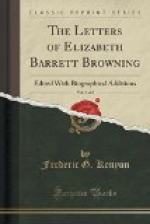Your affectionate and grateful
ELIZABETH B. BARRETT.
[Footnote 54: ‘Crowned and Buried’ (Poetical Works, iii. 9).]
[Footnote 55: Poetical Works, iii. 152.]
The above letter was written only three days before the tragedy which utterly wrecked Elizabeth Barrett’s life for a time, and cast a deep shadow over it which never wholly passed away—the death of her brother Edward through drowning. On July 11, he and two friends had gone for a sail in a small boat. They did not return when they were expected, and presently a rumour came that a boat, answering in appearance to theirs, had been seen to founder in Babbicombe Bay; but it was not until three days later that final confirmation of the disaster was obtained by the discovery of the bodies. What this blow meant to the bereaved sister cannot be told: the horror with which she refers to it, even at a distance of many years, shows how deeply it struck. It was the loss of the brother whom she loved best of all; and she had the misery of thinking that it was to attend on her that he had come to the place where he met his death. Little wonder if Torquay was thenceforward a memory from which she shrank, and if even the sound of the sea became a horror to her.
One natural consequence of this terrible sorrow is a long break in her correspondence. It is not until the beginning of 1841 that she seems to have resumed the thread of her life and to have returned to her literary occupations. Her health had inevitably suffered under the shock, and in the autumn of 1840 Miss Mitford speaks of not daring to expect more than a few months of lingering life. But when things were at the worst, she began unexpectedly to take a turn for the better. Through the winter she slowly gathered strength, and with strength the desire to escape from Torquay, with its dreadful associations, and to return to London. Meanwhile her correspondence with her friends revived, and with Horne in particular she was engaged during 1841 in an active interchange of views with regard to two literary projects. Indeed, it was only the return to work that enabled her to struggle against the numbing effect of the calamity which had overwhelmed her. Some time afterwards (in October 1843) she wrote to Mrs. Martin: ’For my own part and experience—I do not say it as a phrase or in exaggeration, but from very clear and positive conviction—I do believe that I should be mad at this moment, if I had not forced back—dammed out—the current of rushing recollections by work, work, work.’ One of the projects in which she was concerned was ’Chaucer Modernised,’ a scheme for reviving interest in the father of English poetry, suggested in the first instance by Wordsworth, but committed to the care of Horne, as editor, for execution. According to the scheme as originally planned, all the principal poets of the day were to be invited to share the task of transmuting Chaucer into modern




